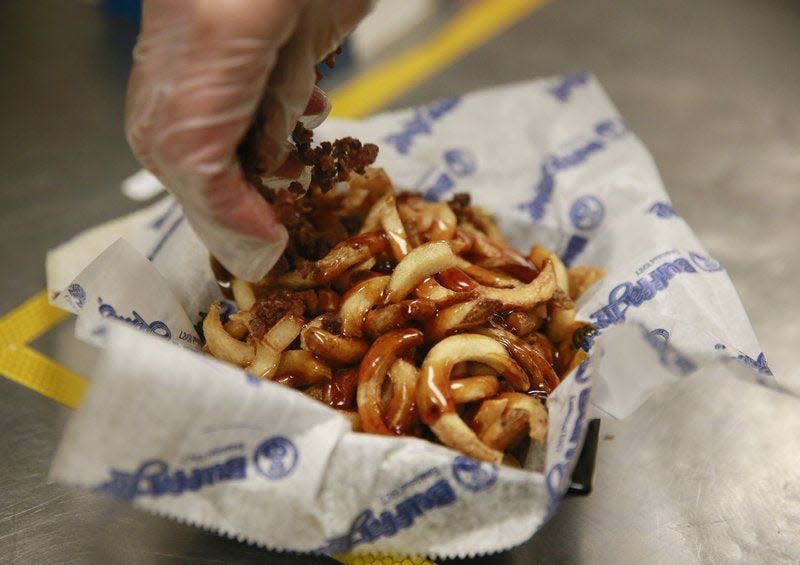Higher wages, reduced hours: How Bloomington businesses are addressing the labor shortage

EDITOR'S NOTE: This is the second story in a three-part series on the COVID-19 pandemic's impact on the local availability of goods, services and employment opportunities. Part one looks at how businesses are adapting. Part three looks at the impact on one major Bloomington employer.
Many Bloomington businesses, especially restaurants, have raised wages as they’re struggling to retain and hire employees. Some businesses are paying more in overtime. Others are reducing their hours because they don’t have enough workers.
Bloomington custom cookie maker Baked is paying employees about 20% more today than a year ago, and its delivery drivers are making about 35% more.
“We’re definitely hiking up our wages as quickly and significantly as we can,” co-owner Jeremy Ness told The Herald-Times.
Employees at BuffaLouie’s and Cresent Donut also have gotten paycheck boosts, but the doughnut shop still had to cut its hours.
Like many businesses across the country, the local restaurants have made adjustments to overcome a pandemic-induced worker shortage caused by an unusually high number of people staying out of the workforce, an Indiana University business professor said.
Fewer people participating in work
The labor force participation rate, which measures the share of adults who are working or looking for work, was at 62.9% in September, down 1.5 percentage points from a year ago, according to the Federal Reserve Bank of St. Louis.
More: Cables, chicken, pizza boxes: Supply chain disruptions forcing Bloomington businesses to adjust
That may not sound like much, but it’s the kind of drop that the state economy usually sees over a decade, said Andrew Butters, assistant professor of business economics and public policy at IU's Kelley School of Business.
“To get that sort of move (over two years) is really unprecedented,” he said.
And while the percentage change may appear small, it translates into tens of thousands of Hoosiers who are not working and not looking for work: In September, about 56,000 fewer Hoosiers were in the labor force than two years earlier.
In Monroe County, nearly 1,900 fewer people were employed or looking for work in September than two years earlier.
Butters said some people have decided to retire early, but many others are seeing increased demands in their households. When schools and daycare centers closed at the height of the pandemic, more parents had to stay home to take care of their children or to supervise them while they attended school remotely.
Child care programs are still operating at reduced capacity, because they, too, are struggling for workers. And parents who can find a spot for their little one also are seeing rising costs. According to LendingTree, the average annual cost per child for center-based care rose 17% in Indiana in the past year, to $11,396. Those expenses are eating into the money parents have left at the end of the month, especially as they’re also seeing increased costs related to driving to and from work, professional attire and food.
Child care in Monroe County: Finding it was already difficult. The pandemic made it worse
Child care in Monroe County: Child care centers have addressed challenges during pandemic
Child care in Monroe County: Due to pandemic, programs seeing increased funding, attention
And so, increasingly, adults in two-parent households don’t think it’s an advantage for both of them to work, especially when a significant portion of the secondary income disappears because of child care and work-related expenses. And that calculation doesn’t even include the time that parents spend commuting and the time that they have to spend away from their young children.
Butters said families faced with the rising cost of elder care are reaching similar conclusions.
“These are all factors that are still contributing to the really weak labor force participation number,” he said.

Constant hiring but still short
Ness, of Baked, said he’s experienced labor challenges and rising prices before, but never to this extent.
Baked has about 30 employees, and while it has a core of managers, bakers and drivers, Ness said he has been hiring continually the entire year, and said it feels as though any time he brings on a new employee, another one leaves.
Baked makes made-to-order cookies, allowing people to pick doughs, including sugar, chocolate and peanut butter, add “mix-ins” such as mint chips, cinnamon sugar or pretzels, and add “after-bakes” including vanilla frosting, honey and caramel.
The worker shortage, especially among delivery drivers, has shifted the business model a bit. Pre-pandemic, about half of revenues came from delivery orders. Now about two-thirds come from dine-in and carryout customers.
Ness said Baked has found ways to increase people’s paychecks: Whenever an employee puts in more than eight hours in a day, the additional work counts as overtime. Previously, only hours above 40 per week were counted as overtime. Baked now also pays 1.75 times the hourly pay for overtime, up from 1.5 previously.
Ness said the worker shortage has pushed the business to essentially reinvest all of its profits into its employees.
More: Why Cook is moving some production to other states, Ireland, and Mexico
Cresent Donut owner Melissa Griffitts said she, too, has raised wages, but has struggled to retain and find employees nonetheless.
She had just taken over the shop before the pandemic and had to lay off staff because of restrictions on gatherings. When authorities lifted the restrictions, Griffitts said she had a tough time finding people to work.
“Nobody wanted to come back,” she said.
The shop’s most popular offerings include the maple bacon and apple fritter doughnuts, but it also offers seasonal treats and special items such as Star Wars doughnuts with a lightsaber across the top.
The business is operating now, but Griffitts is still looking for help, especially for part-timers to work on the weekends.
The staffing crunch has forced her to limit the shop’s hours to 6 a.m. to 2 p.m. Wednesday, Thursday and Friday and 7 a.m. to 2 p.m. on weekends. Before the pandemic, she sold doughnuts around the clock.
BuffaLouie’s owner Ed Schwartzman said the restaurant, which features chicken wings, sandwiches and salads, has boosted its wages by about 25%, and while he said staffing levels are adequate, he, too, is looking for delivery drivers.
Gable's Bagels: New Yorker brings bagels by the dozen to Bloomington
BuffaLouie’s sells its wings in batches between 10 and 50 and offers sauces and dry rubs from Memphis BBQ to Rasta Jerk and Loucifer.
Schwartzman said he tries to set the restaurant apart from other potential employers by offering generous benefits including free meals, insurance and a 401(k).
Coming out of the pandemic proved challenging, he said, because a sizable share of prior employees did not come back.
Customer-facing jobs and the pandemic
Ness said restaurants are dealing with another unusual challenge that they have not seen previously: More confrontations with guests. Because of the pandemic, employees frequently have had to encourage patrons to comply with health mandates such as face mask requirements, which, in some cases, has reduced their earnings from tips, and in other cases has simply put them into awkward confrontations.
“Have a customer-facing job ... while getting them to follow the rules ... is definitely pretty hard,” he said.
More: Why Monroe County is the only Indiana county with a mask mandate
Dealing with the pandemic has elicited some self-reflection among restaurant workers and has pushed some of them into other lines of work where they hope to face less mental strain, he said.
And other industries, some of which thrived during the pandemic, are trying to capitalize. Medical manufacturers such as Cook and Catalent also have raised wages. Catalent recently said it was hiring in Bloomington at $18 per hour. No experience necessary. No awkward confrontations with customers.
Acquisition: Catalent buys three more Bloomington properties for nearly $1.2M
And while many office-based businesses have been able to allow their employees to work from home, Ness noted that’s not an option for restaurants.
“We need our people here,” he said.
Butters said some of the people who left the leisure and hospitality industry are not going to come back.
“It’s incredibly hard for this sector in particular,” he said.
The worker shortage is forcing them to be creative about hiring and compensation, Butters said. They have to tap unconventional networks and even more so than usual have to reach out to their current employee base to help find other workers.
He said he expects some of the constraints currently making life more difficult for restaurant operators will ease as the COVID-19 infection risk diminishes and the capacity of child and elder care providers increases.
People who retired early because of the pandemic may not return to the labor force, he said, but that may just have been a “one-time hit” to the economy, as retirement levels may simply return to normal once the pandemic is over.
Some of the pandemic’s longer-term economic effects are not yet clear, he said.
The pandemic required a fast economic shutdown for some sectors while spiking demand in others and then a quick restart for industries that had been forced to cut back. All those fits and starts put the labor market through the wringer, he said.
The way that businesses are adjusting likely will have some long-term consequence and may accelerate pre-pandemic trends such as a push toward automation, Butters said.
“As these firms have to make decisions about adjusting operations or changing the way they do business ... (it) will have implications about what the post-pandemic recovery looks like,” he said.
Boris Ladwig is the city government reporter for The Herald-Times. Contact him at bladwig@heraldt.com.
This article originally appeared on The Herald-Times: Bloomington businesses react to labor shortage: More pay, less hours
